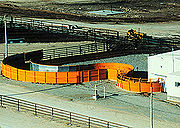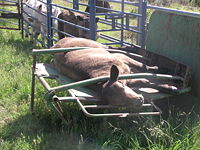
Cattle race
Encyclopedia

North America
North America is a continent wholly within the Northern Hemisphere and almost wholly within the Western Hemisphere. It is also considered a northern subcontinent of the Americas...
) is a narrow corridor built for cattle
Cattle
Cattle are the most common type of large domesticated ungulates. They are a prominent modern member of the subfamily Bovinae, are the most widespread species of the genus Bos, and are most commonly classified collectively as Bos primigenius...
, sheep, pig
Pig
A pig is any of the animals in the genus Sus, within the Suidae family of even-toed ungulates. Pigs include the domestic pig, its ancestor the wild boar, and several other wild relatives...
s and other animals to travel through when being moved from one location to another that is nearby. A conventional race consists of parallel panels or fences with a space between them just wide enough for one animal to pass through comfortably without being able to turn around, thus forming the animals into a queue
Queue
A queue is a particular kind of collection in which the entities in the collection are kept in order and the principal operations on the collection are the addition of entities to the rear terminal position and removal of entities from the front terminal position. This makes the queue a...
that only allows them to go forward. It is used for routine husbandry activities such as drafting (sorting) or loading animals via ramp or loading chute into a vehicle; placing them one at a time in a cattle crush
Cattle crush
A cattle crush , squeeze chute , standing stock, or simply stock is a strongly built stall or cage for holding cattle, horses, or other livestock safely while they are examined, marked, or given veterinary treatment. Cows may be made to suckle calves in a crush...
(variations also called a squeeze chute or standing stock) for examination, marking or veterinary treatment. They are also used at packing plants to move animals into a crush designed for slaughter.
Overview

Temple Grandin
Temple Grandin is an American doctor of animal science and professor at Colorado State University, bestselling author, and consultant to the livestock industry on animal behavior...
gradually narrows so that cattle have ample time to form the queue, and curves to encourage cattle to move forward in a controlled manner (see photo).
Calves (and other smaller animals such as sheep) can turn around in an adult cattle race, so a narrower race is required for proper handling. Thus the width of some races are adjustable to accommodate different sized animals.

The length of the race is usually determined by the size of the herd – a longer one requires less penning-up of a larger herd. Longer races may be curved, to improve the movement of the animals. However races longer than 24 feet tend to cause trouble with the flow of the animals into the loading chute or cattle crush. A walkway may be provided on the outside of the race on one or both sides to allow handlers easier handling, examination or treatment of animals from above.
There are gates at the start and end of the race to regulate the movement of animals. The entrance is from a small funnel-shaped or semi-circular forcing pen (or forcing yard or crowding tub), where a gate is used to move cattle into the race. The gates are usually arranged so the operator cannot become trapped or injured by the cattle. This is achieved in several ways: using a sliding gate operated from outside the race commonly found between the exit of the crowding tub and the entrance to the race, in the middle of the race itself or at the end of the race in entrance to the crush or loading chute; unlatching exit gates by a remotely operated cord; or for a forcing pen gate which uses a self-locking brake-latch that will lock if animals move back on it but is be pushed forward by the handler. A latch is pulled back to unlock the gate so that it can open to another batch of livestock waiting to be forced in behind the previous batch. This forcing pen gate can swing at an angle of 180° to 300°.

Calf race
A calf race and cradle makes calf branding and castration much quicker and cleaner. The calf is forced into a crush like that of a normal crush except it is pushed to one side and held by steel bars as shown in the photo on the right. Note that the bars are nowhere near the belly region of the calf, only located on the neck and in front of the stifle. Then one side of the crush is tipped 90°, exposing the side of the calf to be branded or examined. Calf cradles are available in temporary or permanent styles like that described above. The steel transportable race and table cradle as shown in the photo are the most popular in Australia and New Zealand, but are also found in North America.External links
- Beef cattle yards for less than 100 head (5th ed), New South Wales Department of Agriculture, 2003
- Circular cattle yard - 250 head capacity (2nd ed), New South Wales Department of Agriculture, 1999
- Cattle Handling Facilities: Department of Agriculture and Environmental Affairs KwaZulu-Natal
- Beef cattle yards: Queensland Government Department of Primary Industries and Fisheries

